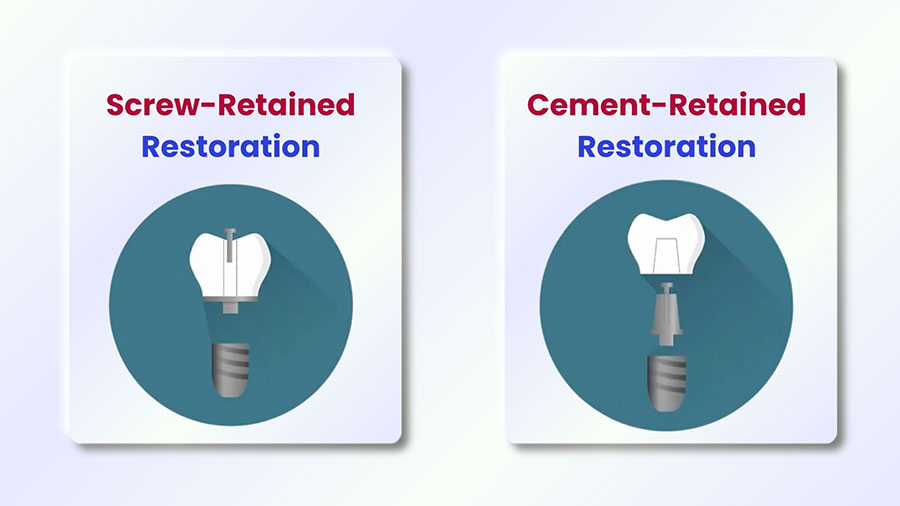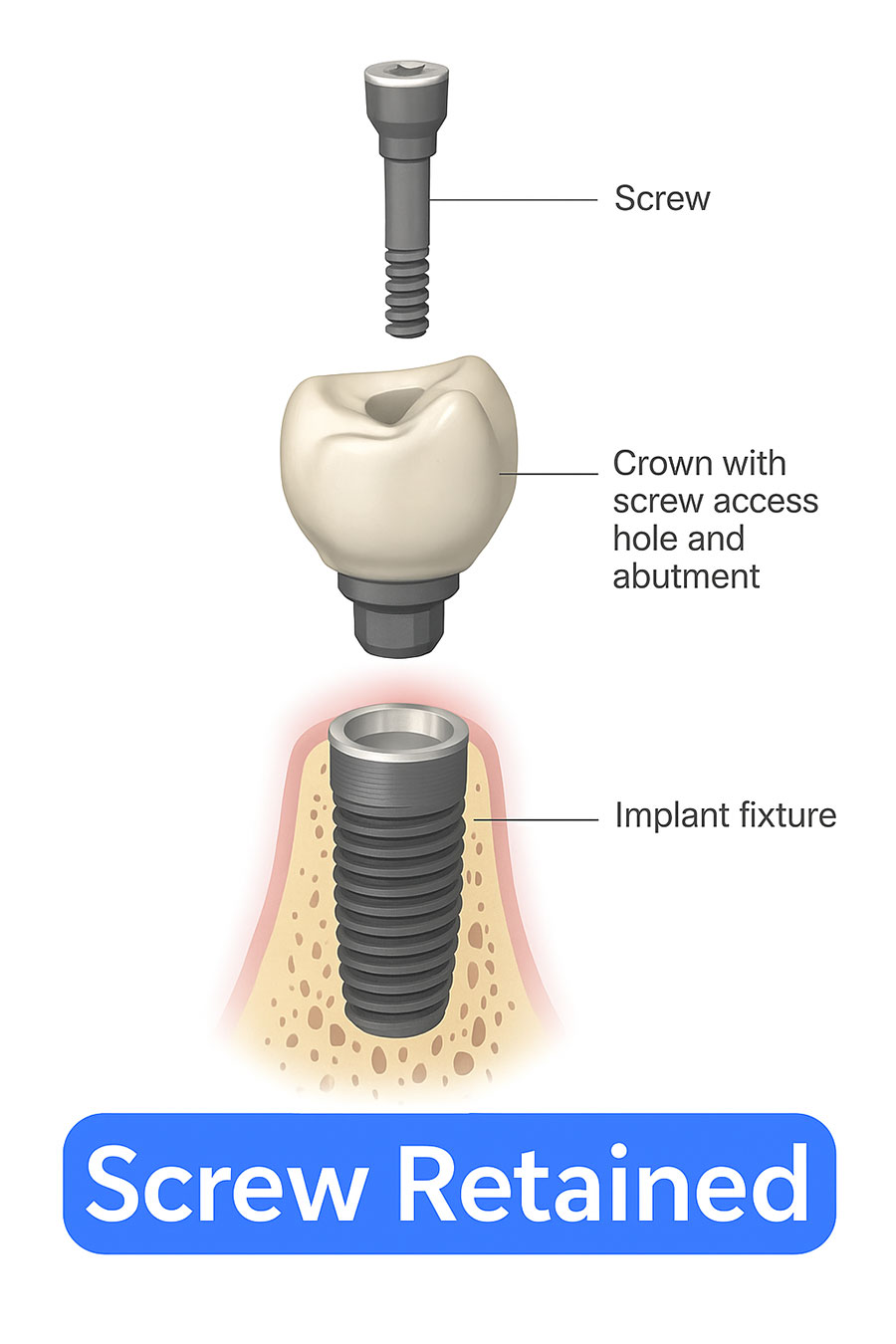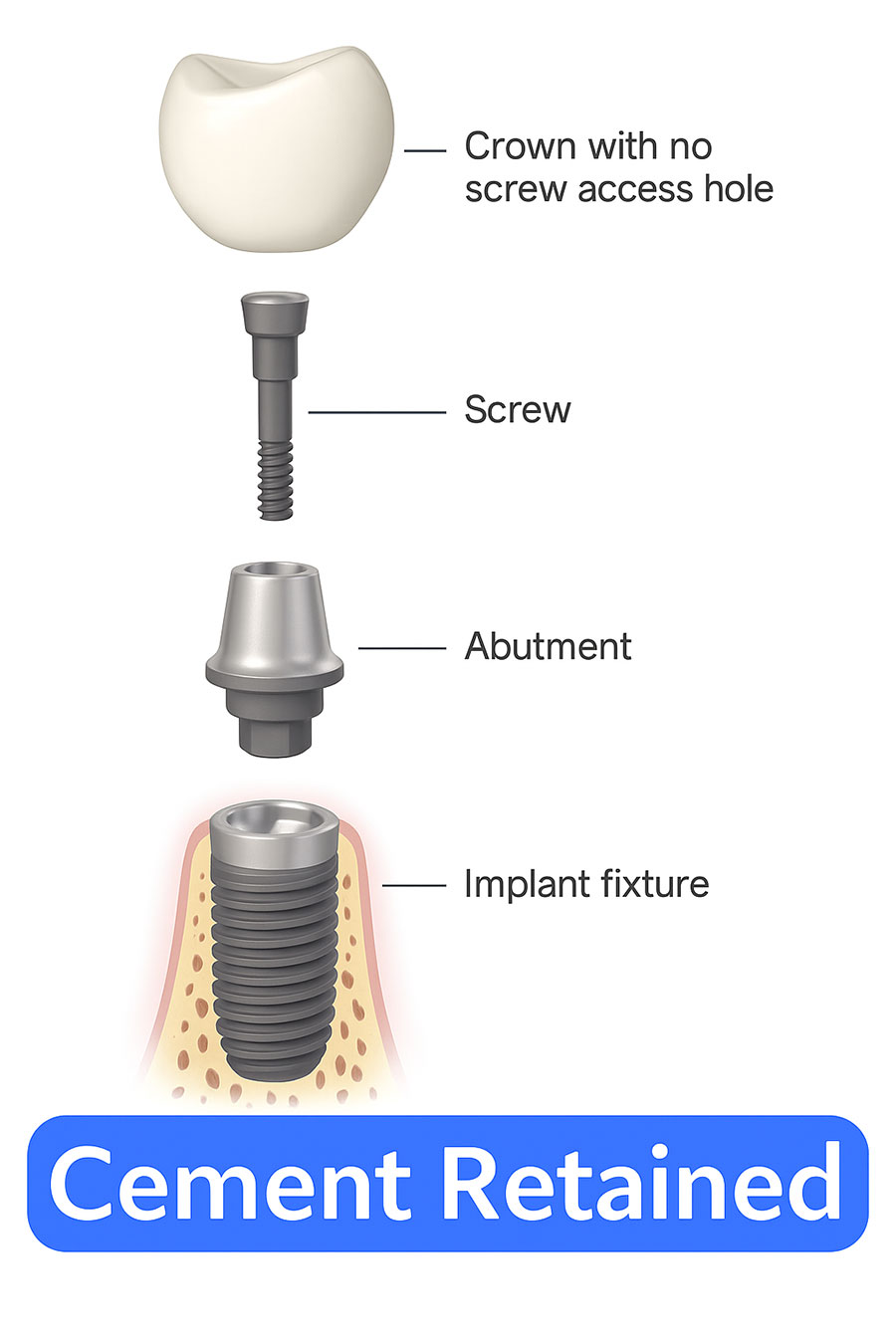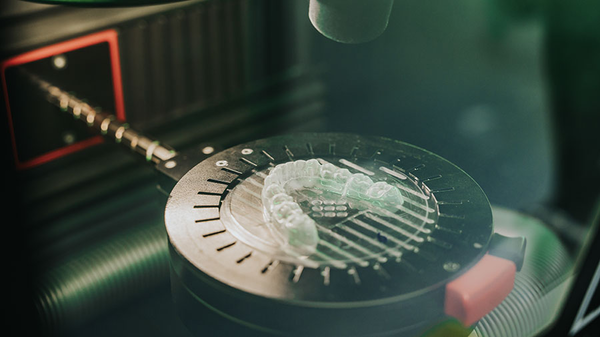This article compares screw-retained and cement-retained implant restorations, highlighting their advantages, limitations, and clinical indications.

Table of contents [Show]
- Introduction
- So, What Is The Difference Between Screw-Retained vs. Cement-Retained?
- What Are Screw-Retained Restorations?
- Advantages of Screw-Retained Restorations
- Disadvantages of Screw-Retained Restorations
- Clinical Indications of Screw-Retained Restorations
- What Are Cement-Retained Restorations?
- Advantages of Cemented-Retained Restorations
- Disadvantages of Cement-Retained Restorations
- Clinical Indications of Cement-Retained Restorations
- Hybrid approach: Screw–Cement-Retained prosthesis
- Conclusions
Introduction
Implant prosthetics have revolutionized modern dentistry by providing durable, functional, and esthetically pleasing solutions for edentulous patients. With reported success rates exceeding 95%, implants have become the gold standard for tooth replacement and full-arch rehabilitation. However, the longevity and performance of an implant restoration are not determined solely by the implant system or the prosthetic material. One of the most critical decisions in restorative planning lies in the type of retention mechanism, whether screw-retained or cement-retained.
For lab owners and prosthodontists, this decision goes beyond personal preference. It directly influences fabrication workflow, long-term maintenance, and the clinical outcome in terms of peri-implant health and patient satisfaction. The type of retention also affects retrievability, esthetics, occlusal function, and cost-effectiveness. Choosing the optimal retention method, therefore, requires a comprehensive understanding of each system’s biomechanical, esthetic, and maintenance characteristics.
At XDENT LAB, we often emphasize that no single retention method is universally superior. Instead, each clinical scenario demands an individualized approach, balancing retrievability, space constraints, tissue management, and esthetic expectations. This article provides a structured, in-depth comparison of screw-retained and cement-retained implant restorations to guide evidence-based decision-making for clinicians and laboratories alike.
So, What Is The Difference Between Screw-Retained vs. Cement-Retained?

Before exploring the nuances, it is essential to understand the basic definition of each type of implant restoration.
A screw-retained restoration is a prosthesis that is directly attached to the implant or abutment with a screw, allowing it to be easily removed for maintenance or repairs. In contrast, a cement-retained restoration is fixed onto the abutment using dental cement, concealing the screw access and achieving a more seamless, natural appearance. In simple terms, the screw-retained design offers retrievability and hygiene convenience, while the cement-retained design focuses on esthetics and simplicity.
For professionals seeking a quick comparison, the table below summarizes the key distinctions between the two retention methods:
| Aspect | Screw-Retained Restoration | Cement-Retained Restoration |
| Retention Mechanism | Directly attached to the implant or abutment with a screw | Fixed onto the abutment using dental cement |
| Retrievability | Fully retrievable for maintenance or repairs | Non-retrievable unless cut or damaged |
| Esthetics | May show screw-access holes; less esthetic in anterior zones | Seamless esthetics; ideal for visible areas |
| Peri-Implant Health | No risk of residual cement; easy to clean | Risk of peri-implant inflammation from excess cement |
| Restorative Space Requirement | Minimum 3.5 mm | Minimum 5.5–7 mm (including abutment height and crown thickness) |
| Fabrication Complexity | Higher lab precision and cost | Simpler and more familiar workflow |
| Indications | Full-arch, limited space, ideal implant angulation | Esthetic zones, non-parallel or tilted implants |
In short, screw-retained restorations prioritize functional control and retrievability, whereas cement-retained restorations prioritize aesthetics and convenience. The optimal choice depends on the specific clinical scenario, restorative space, and the patient’s esthetic expectations.
What Are Screw-Retained Restorations?

Screw-retained restorations involve directly fastening the prosthetic crown or bridge to the implant fixture or abutment using a fixation screw. The screw passes through an access channel in the prosthesis, allowing the clinician to secure or remove the restoration at any time without destroying it. The access hole is later filled with composite or restorative material to restore the occlusal surface.
Screw-retained systems are typically favored in full-arch or long-span restorations, where retrievability and maintenance are critical. They are also ideal when implants are placed in parallel alignment and when vertical restorative space is limited.
Clinically, screw retention is valued for its predictability and direct mechanical linkage, minimizing the dependency on cement adhesion. This makes it particularly suitable in cases requiring frequent follow-ups, hygiene access, or prosthesis repair.
Advantages of Screw-Retained Restorations
Retrievability and Maintenance
The most notable advantage of screw-retained restorations is their retrievability. The prosthesis can be easily unscrewed for inspection, cleaning, or repair without causing structural damage. This is especially beneficial when peri-implant evaluation or screw retightening is required over time. From a laboratory standpoint, retrievability also facilitates post-insertion adjustments or prosthetic upgrades with minimal disruption.
Elimination of Residual Cement Risks
Residual cement is one of the leading causes of peri-implant inflammation and bone loss in cemented restorations. Screw-retained designs eliminate cement entirely, thereby reducing the risk of mucositis and peri-implantitis. This provides a biologically safer environment, particularly for patients with a history of periodontal sensitivity.
Ideal for Limited Restorative Space
When vertical restorative space is restricted, for example, in cases with only 3.5 to 5 mm of clearance, screw retention becomes the preferred choice. Because the abutment and prosthetic are unified, the system requires less occluso-gingival height than a cemented setup, which needs additional space for both abutment height and cement layer.
Simplified Follow-Up and Hygiene
The screw-access design enables routine professional cleaning and screw torque checks. For full-arch prostheses, this ensures long-term stability and ease of maintenance, improving patient satisfaction.
Predictable Passive Fit
With digital workflows and CAD/CAM precision, screw-retained frameworks can achieve highly accurate passive fits. This reduces stress at the implant–abutment interface and minimizes micro-movement, preserving osseointegration.
Disadvantages of Screw-Retained Restorations
Esthetic Limitations
The primary drawback is esthetic compromise. If the screw-access hole emerges through the facial surface, particularly in the anterior zone, it can detract from the visual outcome. While angled screw channels and hybrid abutments help offset this issue, they still present restorative complexity.
Risk of Screw Loosening
Even with optimal torque, screw loosening can occur due to occlusal overload or misfit. Loose screws may lead to microleakage, prosthesis instability, or even implant damage if left unaddressed.
Alignment Sensitivity
Screw-retained restorations require parallel implant placement. Nonparallel or tilted implants may prevent proper seating, leading to stress accumulation or compromised occlusion.
Higher Laboratory Cost
The fabrication of screw-retained systems demands precision components and multiple verification steps, often resulting in higher laboratory costs and longer production times.
Potential for Porcelain Fracture
The presence of a screw-access channel through the occlusal surface increases the risk of porcelain chipping or weakening, especially in posterior load-bearing zones.
Clinical Indications of Screw-Retained Restorations
Screw-retained restorations are most suitable in the following cases:
Limited restorative space (3.5–5 mm) where abutment height for cement retention is inadequate.
Full-arch or long-span fixed prostheses requiring frequent maintenance.
Posterior regions where esthetic demands are lower and hygiene access is crucial.
Parallel implant placement that allows screw-access holes to emerge through occlusal or lingual surfaces.
Patients with a history of peri-implant inflammation, where cement remnants could exacerbate soft-tissue complications.
In essence, screw retention is the clinician’s choice when long-term maintenance, retrievability, and biological safety outweigh esthetic concerns.
What Are Cement-Retained Restorations?

Cement-retained restorations are secured to an implant abutment using dental cement, either temporary or permanent. The abutment is connected to the implant via a screw, but the visible prosthesis itself is cemented, concealing the access hole and providing an unbroken surface.
Cemented restorations are often the preferred solution for single crowns or short-span bridges in the esthetic zone, where achieving a lifelike appearance is paramount. The absence of a visible access channel enables better control over contour, translucency, and surface texture.
This retention method also offers greater flexibility in managing non-parallel implants, as the prosthesis can be seated independently of the screw axis. However, it introduces challenges related to cement management and retrievability.
Advantages of Cemented-Retained Restorations
Superior Esthetics
Cemented restorations deliver unmatched esthetic integration. The lack of a screw-access hole allows for a seamless emergence profile and natural occlusal morphology. In anterior cases, this design facilitates the creation of a translucent incisal edge and lifelike enamel characteristics.
Passive Fit and Simplicity
When properly executed, cementation offers a stress-free and passive fit, reducing microstrain between the prosthesis and abutment. Clinicians and labs often favor cementation for its familiar workflow, simplicity, and fewer technical components.
Flexibility in Nonparallel Implant Placement
Cement-retained designs accommodate angled or tilted implants, providing flexibility when anatomical or surgical constraints prevent parallel placement. The prosthetic path of insertion can be customized through abutment angulation, simplifying occlusal alignment.
Reduced Porcelain Fracture Risk
Unlike screw-retained restorations, cemented designs lack an access hole through the occlusal surface, minimizing structural weaknesses and reducing the likelihood of porcelain chipping.
Enhanced Esthetic Control for Labs
From a laboratory perspective, cement-retained cases allow for unrestricted artistic control in contouring, color layering, and achieving a balanced esthetic harmony with adjacent dentition.
Disadvantages of Cement-Retained Restorations
Risk of Residual Cement and Peri-Implant Complications
Residual cement remains the major drawback. Even minute traces left subgingivally can provoke chronic inflammation, peri-implant mucositis, or peri-implantitis. Over time, this can compromise bone stability and implant longevity. The difficulty lies in detecting and removing excess cement, especially when margins are placed deep beneath the gingiva.
How to prevent this: Various preventive measures have been proposed to mitigate the potential dangers of residual cement in cement-retained restorations. These include using a controlled cementation technique, provisional cementation prior to final placement, or temporary abutments that facilitate the removal of excess cement before definitive restoration. Moreover, the development of custom abutments, initially through wax-and-cast techniques and now via CAD/CAM fabrication, allows for supragingival or equigingival margin placement. These more accessible margins are easier to clean and inspect, significantly reducing the risk of biological complications associated with cement remnants.
Difficult Maintenance and Retrievability
Cemented restorations are not easily retrievable. Any need for abutment tightening, screw replacement, or implant site assessment may require the destruction of the prosthesis. This limitation becomes significant in full-arch or multi-unit restorations where future maintenance is inevitable.
Technique Sensitivity
Achieving ideal cementation requires precise margin placement, cement volume control, and complete excess removal. Suboptimal technique can lead to residual cement, decementation, or uneven marginal fit.
Greater Restorative Space Requirement
Cement-retained prostheses demand a minimum abutment height of 4 mm and 1.5–2 mm for crown material, totaling around 5.5–7 mm. This makes them unsuitable for cases with limited vertical clearance.
Biologic Risk from Microleakage
In cases of imperfect cementation, microgaps can harbor bacteria, contributing to peri-implant biofilm accumulation. Over time, this may lead to mucosal irritation and marginal bone loss.
Clinical Indications of Cement-Retained Restorations
Cement retention is best indicated when:
Esthetic requirements dominate, particularly in the anterior maxilla.
Implants are nonparallel or tilted, requiring customized abutment angulation.
Sufficient restorative space (>5.5 mm) is available.
Patient hygiene is well-maintained, and regular follow-ups can monitor tissue health.
Single or short-span restorations are required, where retrievability is less critical.
Hybrid approach: Screw–Cement-Retained prosthesis
In recent years, a hybrid approach combining both retention systems has gained momentum. Known as the screw–cement-retained prosthesis, this design integrates a screw-retained framework with a cemented superstructure. In essence, the framework is screwed into the implant, while the individual crowns are cemented onto it.
Conclusions
Both screw-retained and cement-retained restorations have well-established clinical roles in implant prosthodontics. Screw-retained restorations provide unmatched retrievability, maintenance ease, and biological safety — making them ideal for posterior or full-arch cases, or when restorative space is limited. In contrast, cement-retained restorations excel in esthetic precision and flexibility, particularly for anterior single units or when implants are nonparallel.
Ultimately, the decision should be guided by a holistic understanding of clinical parameters, including restorative space, implant angulation, hygiene accessibility, and patient esthetic expectations. The key is not to choose between screw or cement, but to select the approach that ensures long-term stability, peri-implant health, and patient satisfaction.
As laboratory and clinical technologies continue to evolve, collaborations between prosthodontists and advanced digital labs like XDENT LAB become essential. Through precision-driven workflows and a deep understanding of clinical intent, such partnerships empower practitioners to deliver restorations that are not only functionally superior but also biologically and esthetically sustainable.
Acknowledgement:
Stress Distribution in Peri-implant Bone of Implants Restored with Screw, Cement, and Cement-Screw Retained Crowns Using Three Crown Materials: a Three-dimensional Finite Element Analysis, written by Pasad et al. 2025.
Single Dental Implant Restoration: Cemented or Screw-Retained? A Systematic Review of Multi-Factor Randomized Clinical Trials, written by Fiorillo et al. 2024.
Evaluation of Marginal Bone Loss and Esthetics in Screw vs Cement-retained Single Implant Prosthesis: A Systematic Review, written by Sajjanar et al. 2025.
XDENT LAB is an expert in Lab-to-Lab Full Service from Vietnam, with the signature services of Removable & Implant, meeting U.S. market standards – approved by FDA & ISO. Founded in 2017, XDENT LAB has grown from local root to global reach, scaling with 2 factories and over 100 employees.. Our state-of-the-art technology, certified technicians, and commitment to compliance make us the trusted choice for dental practices looking to ensure quality and consistency in their products.

Our commitments are:
100% FDA-Approved Materials.
Large-Scale Manufacturing, high volume, remake rate < 1%.
2~3 days in lab (*digital file).
Your cost savings 30%.
Uninterrupted Manufacturing 365 days a year.
Contact us today to establish a strategy to reduce operating costs.
--------❃--------
Vietnam Dental Laboratory - XDENT LAB
🏢 Factory 1: 95/6 Tran Van Kieu Street, Binh Phu Ward, Ho Chi Minh City, Vietnam
🏢 Factory 2: Kizuna 3 Industrial Park, Can Giuoc Commune, Tay Ninh Province, Vietnam
☎ Hotline: 0919 796 718 📰 Get detailed pricing
Share this post:
Related Posts

Confused between implant-supported and implant-retained dentures? This expert guide from XDENT LAB explains the differences, pros and cons, cost, and how to choose the right option for your mouth.

Discover how Stereolithography (SLA) is revolutionizing dental 3D printing. Explore academic insights, biocompatible materials, clinical applications, workflow integration, and quality control. Learn...

This article draws insights from the research “Data sharing for responsible artificial intelligence in dentistry: a narrative review of legal frameworks and privacy-preserving techniques”, written by...


